Introduction to Ocean Thermodynamics
Table of Contents
1 Purpose:
It is not reasonable to expect to have a good understanding of the Earth's climate nor atmospheric processes without some insight into the character of the oceans. This illustrative and qualitative overview is meant to help familiarize you with the oceans.
\bikskip
Please let me know if there are any questions or interest in expanding on this material.
\bigskip
The data from the three sensors; AIRS, CRIS & IASI that are available to us extending over 12 years and including measurements in the atmospheric window regions for views that are clear of cloud, gives us the possibility to investigate the evolution of sea surface temperature over this period. The variation of SST over various spatial and temporal scales would be particularly interesting. There is much ongoing research into the role and response of the oceans to climate change, and our methods could be adapted to include ocean SST. In any case, since we often use model SST data, it is worth having a reasonable understanding of the state of the oceans.
\bigskip The role of the oceans in controlling Earth's climate are without question the transport and storage of heat.
For a current (as of time of writing) global SST maps - see figure 1.
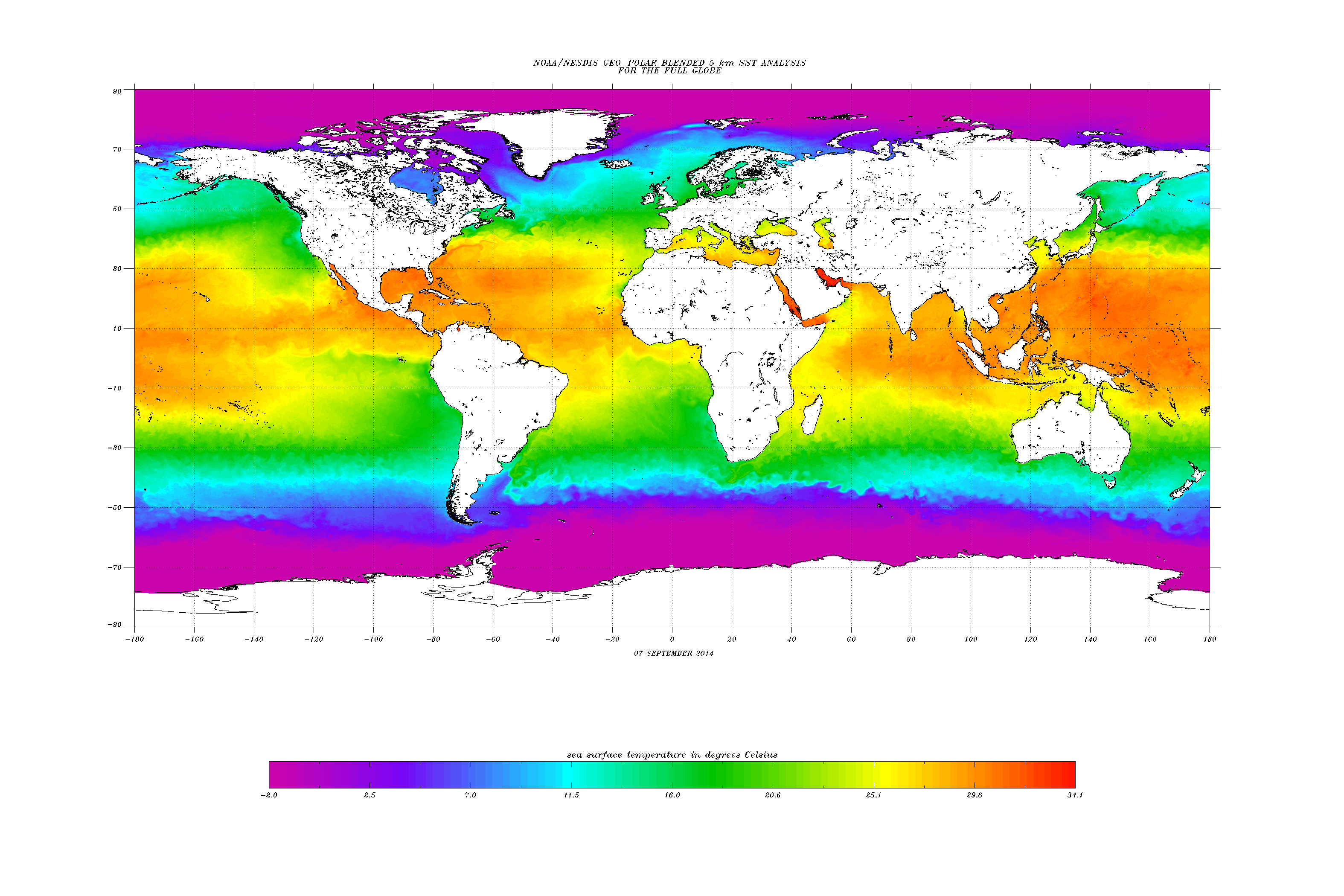
2 Ocean Currents.
There are two main driving forces for ocean currents; surface wind and the (horizontal) gradients in temperature and salinity. Other (more local) causes are the lunar tides and river/ice-melt flow from the land. It is reasonable to note that the two have very different time-scales (when considering the theoretical return-time for a parcel of water to it's starting position).
2.1 Surface Wind Driven
Once the patterns of atmospheric flow are known the surface currents can be better understood. The dynamics involved include direct wind stress and Ekman transport and, more subtley, the curl of the wind vector and surface buoyancy changes due to heat and water flux. Although much of the surface flow is in the horizontal direction, the surface flow induces over-turning, especially near coastal boundaries, and turbulence (surface wave action) and eddy diffusion causes vertical transport.
Figure 2 shows the best picture of the overall surface wind driven ocean currents.
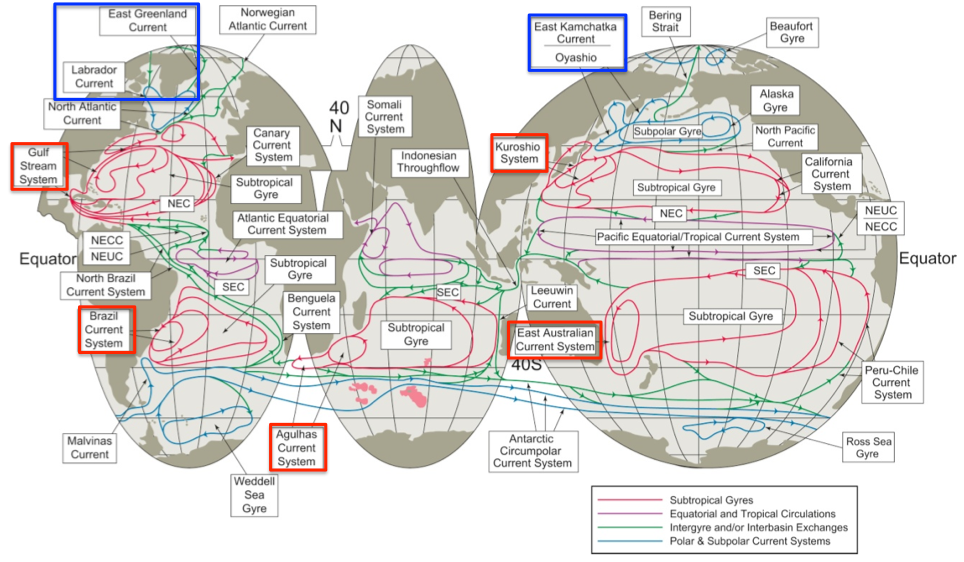 Of particular note are the five gyres, resuting from the wind curl from the sub-tropical anticyclones that are situated there. Also note the un-hindered Antarctic circumpolar flow, and the Pacific equatorial easterly flow. It is worth spending some time familiarizing yourself with these.
In terms of surface flow, in figure 3, note the relatively strong western boundary flows, the Tropical flows and the Antarctic flow.
Of particular note are the five gyres, resuting from the wind curl from the sub-tropical anticyclones that are situated there. Also note the un-hindered Antarctic circumpolar flow, and the Pacific equatorial easterly flow. It is worth spending some time familiarizing yourself with these.
In terms of surface flow, in figure 3, note the relatively strong western boundary flows, the Tropical flows and the Antarctic flow.

Surface velocity streamlines in cm/sec.
Not shown here is the tendancy for the surface to be higher in the western end of the ocean basins compared to the east (by as much as a meter).
The important concept to remember about the surface wind stress is that it induces a mass flow near the ocean surface with mean vector at right angles (clockwise in the N.H., anticlockwise in the S.H.) of the wind vector (called Ekman transport). Secondly, the horizontal variation of the wind stress causes divergence (convergence) of the Ekman flow to the left (right) of a wind maximum. Where the Ekman flow diverges (converges) there is a upwelling (downwelling) response (referred to as Ekman pumping). In other words where the curl of the wind stress is positive (negative) there is upwelling (downwelling) in the N.H. (Wind stress has units N.m-3). In theory, if the wind max is on the equator there is upwelling as shown in figure 4.
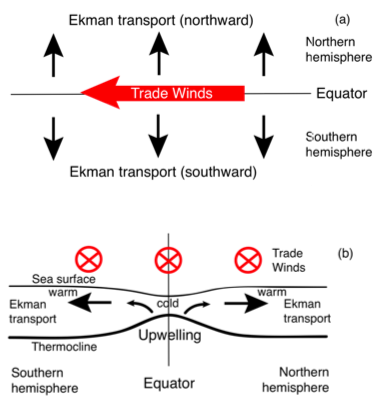
Ekman transport on the euquator. Note the effect of surface height and thermal change.
In the open oceans, the ocean gyres are associated with the Ekman up- and down-welling as shown in figure 5 as described, and also with a meridional flow which results from the change in mass balance, referred to as Sverdrup transport, which occurs at a mean depth dependent upon the strength of the Ekman pumping and height of mean thermocline (a few tens of meters typically).
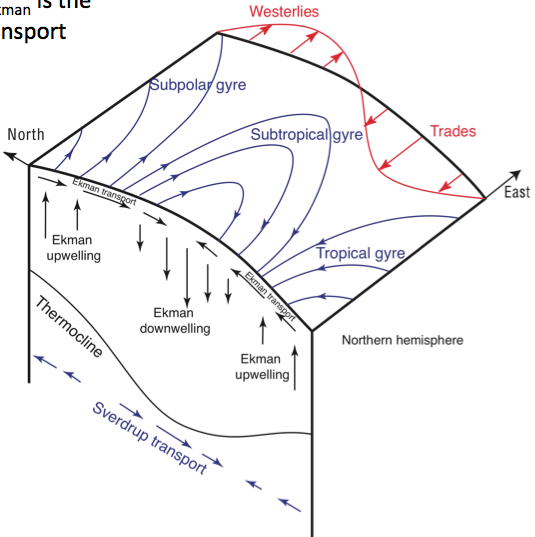
The wind driven surface currents have the effect of redistributing mass and heat most famously in the form of the gulf stream. It should be remembered that without surface currents the horizontal variation of ocean temperature would be dominated by sensible and latent heat flux (mostly solar heating and infra-red cooling). For example see figure 6.
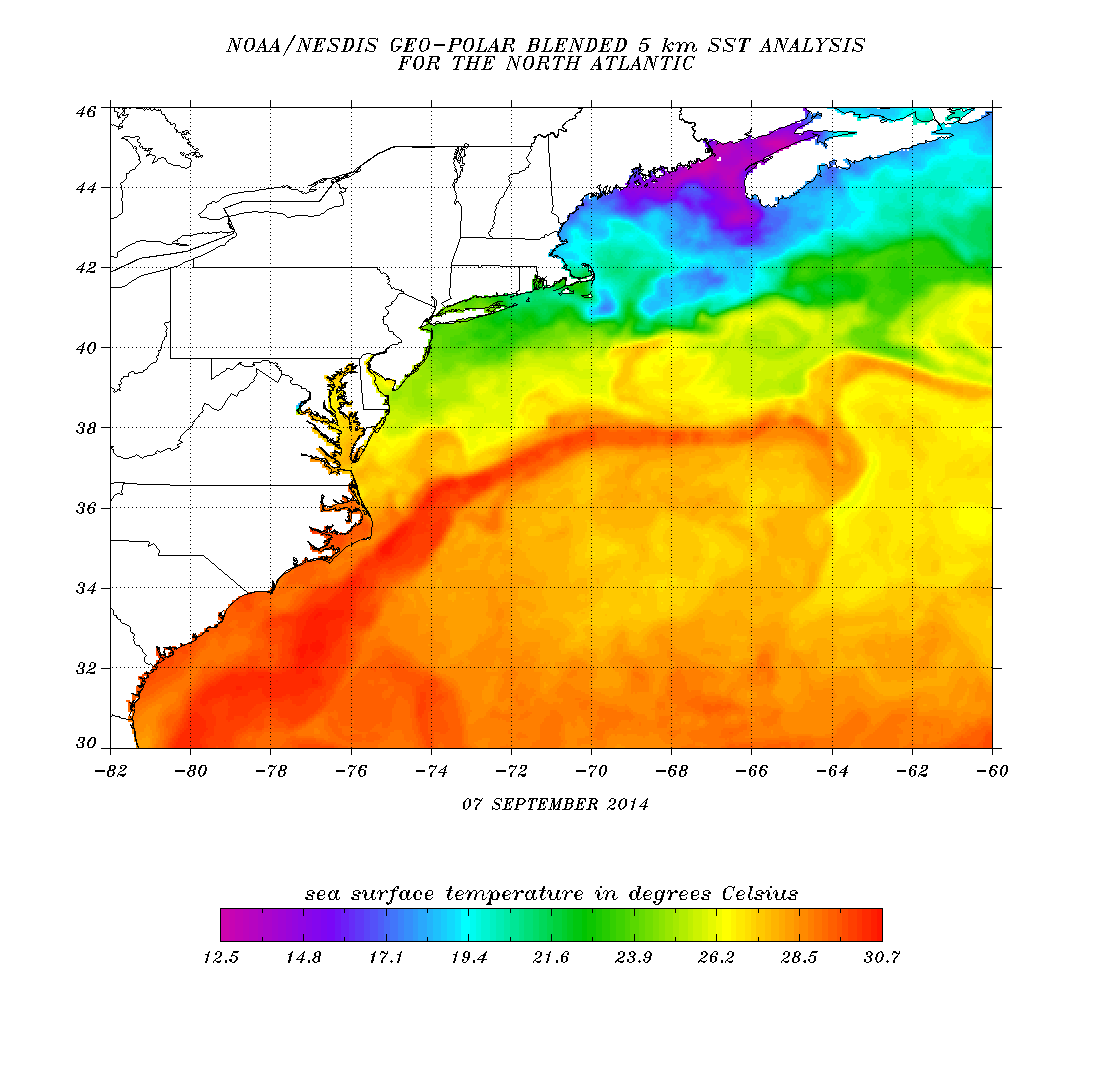
SST analysis 7-Sep-2014, NOAA-NESDIS.
Note that the close circuit mass balance must be zero (neglecting evaporation etc), but note also that in every gyre there is a net poleward heat transport.
The resultant non-equilibrium thermal state of the ocean caused by wind driven circulation results in heat flox into the ocean is shown in figure 7.
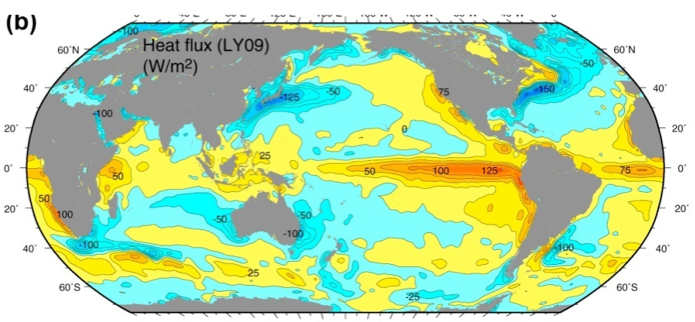
Surface heat flux analysis (+ve = heat added to ocean).
2.2 Deep Ocean Circulation
The horizontal variation of the temperature and salinity of the oceans results in density variations and therefore a horizontal pressure force that drives the motion of water parcels to regions of equal density. The global scale variation results from the pole-equator variation in solar/infrared heating/cooling. The overall effect is to generate deep meridional over-turning circulations and these are greatest where so-called 'deep water formation sites' are found. These are principally the Nordic Seas Overflow waters; and several Antarctic Bottom Water Sites. The situation is more complicated as illustrated in figure 8.
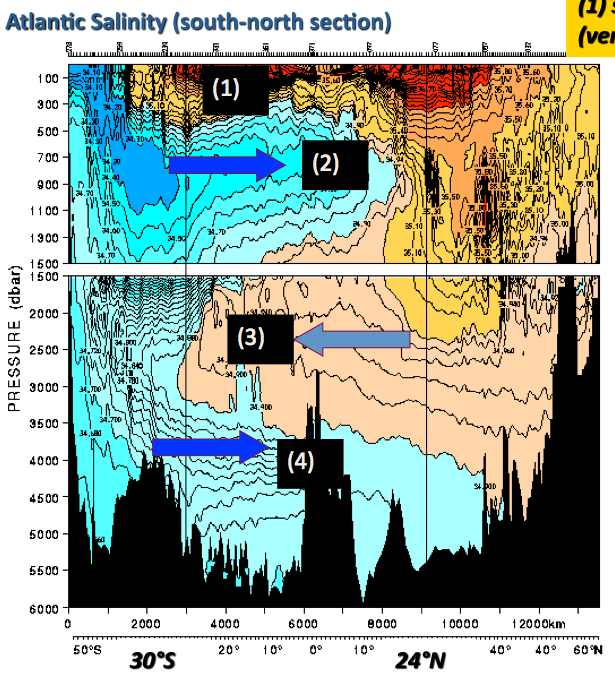
Atlantic salinity section. 1: Surface waters, 2: Low salinity Atlantic intermediate water (AAIW). 3: High salinity north Atlantic (NADW). 4 Low salinity Antarctic bottom water.
It should be noted that NADW dominates the deep overturning of the Atlantic Ocean, whereas the AABW dominates the Pacific overturning. (Almost obvious if you think about it).
The net result is the observed global overturning circulation illustrated in figure 9
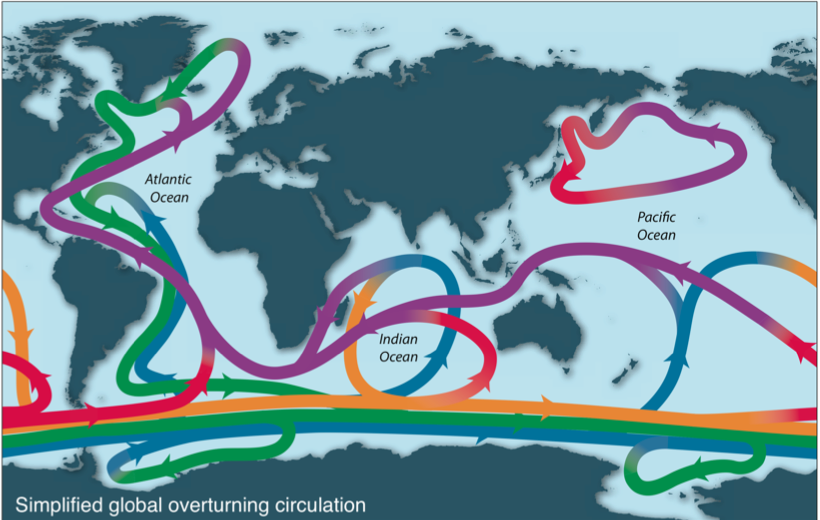
Global overturnig illustration (warm colour suggesting depth)
It is interesting to note that the Atlantic Ocean on average is warmer and more saline than the Pacific ocean. Furthermore, and rather intriguingly the three ocean basins are coupled via the Antarctic circumpolar system, as illustrated in figure 10

Souther Ocean Connection with global overturning.
2.3 Summary
It is self evident that the ocean thermal structure and dynamics are complex and inter-related to the atmosphere and the global energy balance. They have a very large capacity to store and redistribute heat around the globe. The state of the ocean at any one time is a result of the past state and is in some form of quasi balance with the driving forces that inflience it. There are processes that have different time constants associated with them, and it is not hard to see how many of these processes interact with each other and can exhibit periodicity (varying around some mean state).
Some examples of these are the ENSO: \\ (http://www.pmel.noaa.gov/tao/elnino/nino-home.html),
See Figure 11
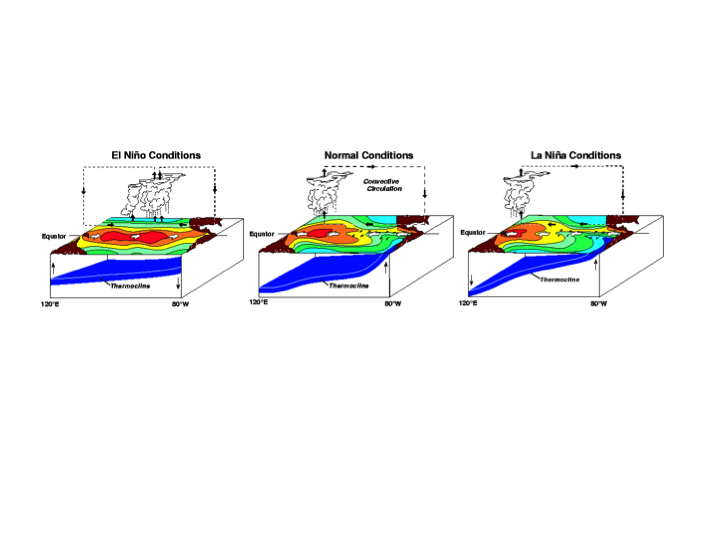
Schematic illustration of morphology of El Nino cycle.
the IOD and
http://www.nature.com/nature/journal/v401/n6751/abs/401360a0.html
PDO: e.g.
(Bond, N.A., and D.E. Harrison 2000: The Pacific Decadal Oscillation, air-sea interaction and central north Pacific winter atmospheric regimes. Geophys. Res. Lett., 27(5), doi: 10.1029/1999GL010847, 731–734).
3 Appendices
3.1 Data Sources and References
International Comprehensive Ocean-Atmosphere Data Set (ICOADS)
http://icoads.noaa.gov/news.html
The KNMI Climate Explorer website: http://climexp.knmi.nl/
NOAA OPSO SST charts http://www.ospo.noaa.gov/Products/ocean/sst/contour/
From the Australian Bureau of Meteorlogy http://www.bom.gov.au/marine/sst.shtml
The Pacific Marine Environmental Laboratory http://www.pmel.noaa.gov
Much of the graphical material coutesy of: http://cdsagenda5.ictp.trieste.it/full_display.php?ida=a10153